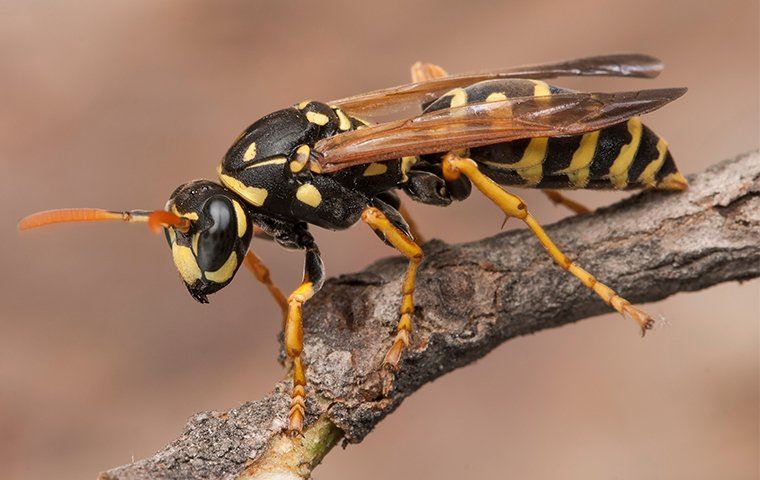
Stinging Insect Identification Guide
What are stinging insects?
Stinging insects are a group of beneficial insects that are responsible for pollinating plants, flowers, and crops. Many species of stinging insects are predators and help to control nuisance insects and small garden pests. Common types of stinging insects living in our Utah service area are wasps, hornets, yellow jackets, and mud daubers.

As their name suggests, stinging insects have a venom-filled stinger coming off the end of their abdomen. They use their stingers to paralyze their prey or as a way to defend themselves. When stinging insects decide to place their nest near, on, or in your home, their threats outweigh their benefits, and they turn from beneficial pests to unwanted pests.
What kind of stinging insects are found in Salt Lake City?
The three most common types of wasps that you will have issues with are Yellowjackets, Paper Wasps, Mud Daubers.
- Paper Wasps tend to be less aggressive. Usually, they only sting when they or their nests are in danger. Their nests are generally found hanging from eaves of homes, fences, etc.
- Mud Daubers get their name from the nests they make. They make their nests out of mud and are generally found on walls. They have skinnier bodies than paper wasps and Yellowjackets and like paper wasps, they are less aggressive than Yellowjackets.
- Yellowjackets are significantly more aggressive than Paper Wasps and Mud Daubers. They tend to have larger nests and larger colonies. Most of the time they make their nests underground or inside walls.
Are stinging insects dangerous?
Stinging insects can be very dangerous. The venom that stinging insects inject after stinging a person can trigger severe allergic reactions that require medical attention. Anaphylaxis can occur in those severely allergic or in the case of a group attack, and when stinging insects build their nest in a high-traffic area of our home or yard, the chances of getting stung increases dramatically. Care should always be taken around stinging insects. Nests placed in high traffic areas should be removed by a trained professional.
Why do I have a stinging insect problem?
The biggest reason why stinging insects become a problem on our properties is that there are ample places to nest and forage for food. Many species use trees, dense vegetation, and sheltered areas on our houses as nesting sites. Stinging insects feed on plant nectar, proteins, and sweets, and they forage for food in our yards around gardens, garbage cans, compost piles, recycling bins, and outdoor eating areas.
Where will I find stinging insects?
Where stinging insects build their nests depends on their species. Hornets, wasps, and mud daubers like to build their nests in protected areas like under overhangs, between rocks, or in woodpiles. They may also make their nests in trees, on utility poles, under decks, or in door frames.
Yellowjackets, on the other hand, nest on or in the ground. They build their nests under woodpiles, bushes, between rocks, or in the abandoned nests of small animals.

WHY CHOOSE OUR TEAM?
Where Value Meets Effectiveness in Pest Control
Our services are designed to help make your indoor space more comfortable and save more money! Pest Pro Pest Control offers a full-range of HVAC services to address any of your residential or commercial needs.
-
Family & Pet Friendly Pest Control
We use EPA-registered products and targeted treatment methods designed to protect your family, pets, and home while effectively eliminating pests. Your safety is our top priority.
-
Trusted by Thousands
With more than 1,400 five-star Google reviews, multiple Best of SLC awards, Best of Utah, and winner of 2025 Nextdoor Fave, Pest Pro is one of Utah’s highest-rated pest control companies. Homeowners and businesses choose us for reliable results and outstanding service.
-
Honest, No-Pressure Service
We never do door-to-door sales or use high-pressure tactics. Our recommendations are based solely on what your home needs, not on sales quotas or gimmicks.
How do I get rid of stinging insects?
A stinging insect infestation is a frustrating pest problem. The easiest way to get rid of stinging insects and other pests is to partner with Pest Pro Pest Control. We provide the effective home pest control and commercial pest control services needed to protect Utah residential and commercial properties from insects, rodents, and other pests.
At Pest Pro Pest Control, we are committed to helping Utah home and business owners maintain pest-free properties with our guaranteed pest control services. For more information about our stinging insect control treatments, reach out to Pest Pro Pest Control today!
How can I prevent stinging insects in the future?
Keep your Salt Lake City home and yard protected from stinging insects with the help of Pest Pro Pest Control and the following prevention tips:
- When eating outside, keep food and drinks covered until you are ready to eat.
- After eating outside, clean-up all food and drinks quickly.
- Remove areas of standing water from your property that stinging insects could use as a source of water.
- Don’t overplant flowering vegetation on your property.
- Remove fallen trees, logs, and tree stumps from your yard.
- Fill-in ground holes around your yard.
- Place tight-fitting lids on all garbage cans, recycling bins, and compost bins.
- Cut back trees branches and shrubs from your home’s exterior walls.
- Caulk up openings in your home’s exterior walls and roofline.
- Keep stinging insects out of your home by repairing loose or broken screens and placing tight-fitting caps on chimneys.


What Utah Home and Business owners Are Saying About Pest Pro
Don't Take Our Word For It, Hear It From Our Customers
At Pest Pro Pest Control, your satisfaction is our priority! See for yourself what our customers have to say about working with us.
-
"We are so pleased we decided to go with Pest Pro."Excellent customer service from Conner yesterday. How refreshing to be able to talk to the people doing the work and get detailed information about the plan to protect our home and yard.- Jayne A.
-
"Nothing but courteous and thorough."Pest Pro is an awesome and reliable team we can count on to take care of all of the things we need around the house. Bryce was friendly and took care of a nest starting in our grill (thank goodness he did).- Sara G.
-
"Always done a great job for me."The people that come out are knowledge, friendly, and great to work with. Both Conner and Bryce that came to my home recently did a great job. I would recommend them to anyone.- Nate W.
-
"Top-notch, super pleasant and very helpful."I love the level of customer service this company provides. It is hard to come by these days. All the techs that come out are top-notch, super pleasant and very helpful. Today, we had Edgar come out and he went the extra mile, as always.- Amy S.
-
"The whole experience was wonderful."I had the lovely experience of meeting Bryce Bollinger a tech with Pest Pro. Definitely have trust with Bryce and Pest Pro- Ted C.
-
"I will definitely hire Pest Pro again."Wow! Bryce was amazing. He spent so much time locating and removing yellow jacket nests from my deck. This was such a great value and everyone from this company was pleasant and prioritized customer experience.- Maryanne P.
-
"Incredibly professional, kind, and knowledgeable!"Very happy with our experience with Pest Pro. Edgar called when he was on his way, did a very thorough job at spraying for spiders, and when he saw wasps on our property he gave a great wasp treatment as well!- Clara D.
-
"Very professional and thorough!"Connor did a great job with spraying our house! He was very professional and thorough! And we were able to get an appointment quickly!! We will definitely be using Pest Pro again!- Kierstin A.